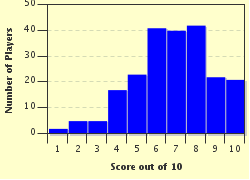Quiz Answer Key and Fun Facts
1. This adopted son of the first Roman Emperor, Augustus, became the second Emperor of the Roman Empire in the year 14 AD. What was his name?
2. In ancient Rome, what would an implement called a strigil have been used for?
3. Which of the following was the name of a coin used as currency in ancient Rome?
4. AD 69 was known as the Year of the Four Emperors. All the following four choices reigned as Emperor during the year, but who was the one who outstayed the others and ended up ruling for almost ten years?
5. It was customary for many wealthy citizens of ancient Rome to take their vacations in the area around Pompeii, and many elaborate villas were built for this purpose, the ruins of some which can still be seen to this day. The eruption of Mount Vesuvius in AD 79 destroyed the cities of Pompeii, Herculaneum and the surrounding area. From the meticulous records of which noted writer did the world learn of this tragedy in great detail?
6. Many of the Roman emperors met violent deaths, either by their own hand or at the hands of others. Which of these four emperors, notable for a 'wall' named after him in Britain, had a more peaceful end to his life, dying of natural causes in the year 138 AD?
7. The Roman Empire was spreading through Europe and in 43 AD, after an initial (unsuccessful) attempt by Julius Caesar in 55 BC, the Romans invaded Britain. What is the name of the Roman palace near Chichester in West Sussex, the ruins of which are still visible today and are a popular tourist attraction?
8. The Roman invasion of Britain took place in the year 43 AD. How do you express the number 43 in Roman numerals?
9. In the world of ancient Rome, which hugely popular aspect of Roman life took place at the Colosseum?
10. Which modern author wrote a series of books depicting life in ancient Rome starring the protagonist Marcus Didius Falco?
Source: Author
Jennifer5
This quiz was reviewed by FunTrivia editor
bloomsby before going online.
Any errors found in FunTrivia content are routinely corrected through our feedback system.

